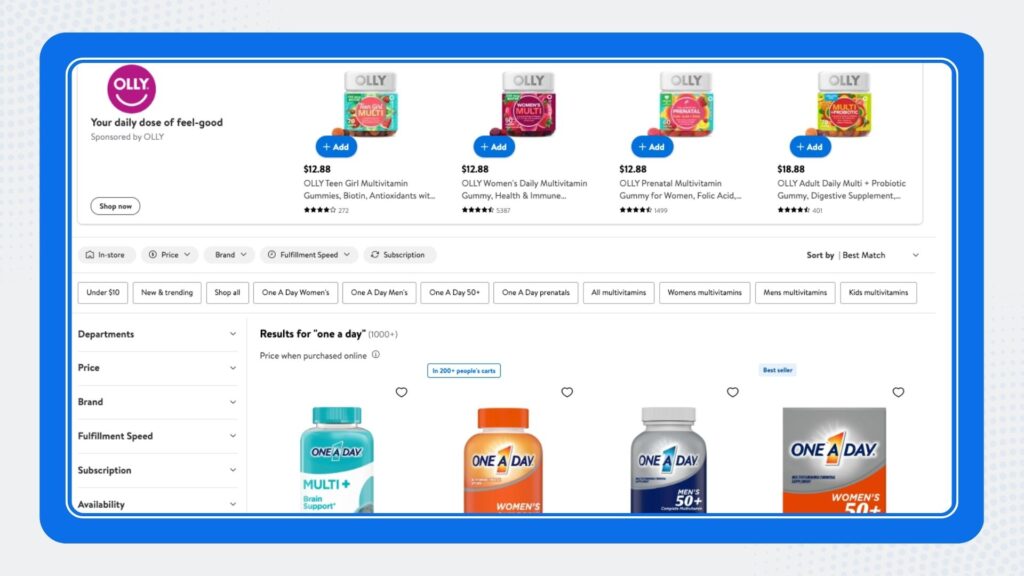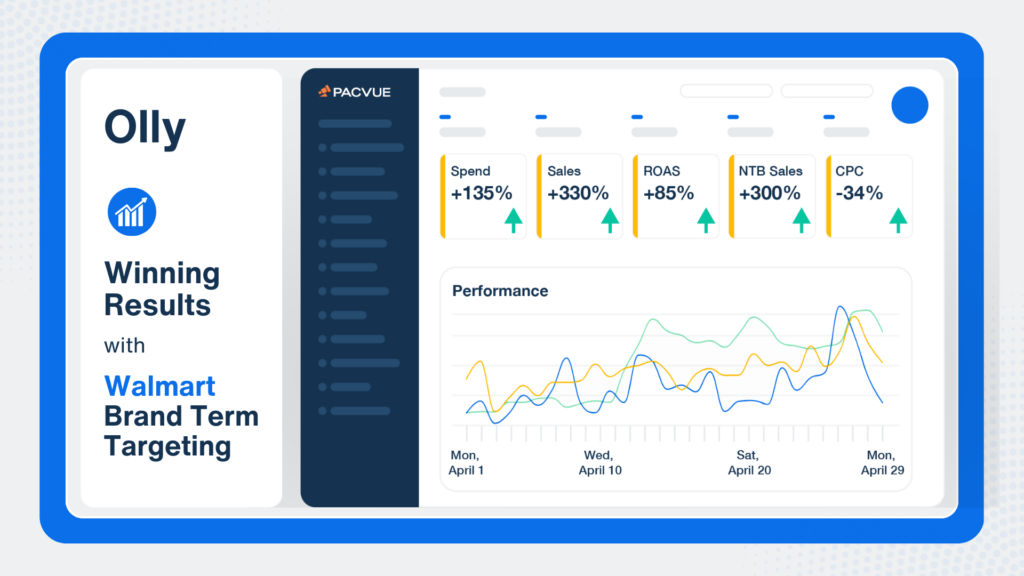Walmart launched Brand Term Targeting in early 2024, giving brands a new way to compete in the ultra-competitive retail media landscape. This latest feature is designed to grow and protect market share, capture new-to-brand shoppers, and increase visibility.
As inflation and consumer desire for cost savings threaten to erode brand loyalty, brands are facing even greater pressure and competition to win their category.
In this Marketplace piece, explore the full potential of Brand Term Targeting to solidify your brand’s category standing, attract new customers, and outpace your competitors.
What is Walmart Connect Brand Term Targeting?
Brand Term Targeting is a new Walmart Connect feature for Sponsored Products, Sponsored Brands, and Sponsored Videos campaigns. It allows brands of all sizes to bid and advertise their products on competitor keywords if the promoted item is relevant to the competitor’s keyword category. This opens opportunities for brands to increase visibility and gain new-to-brand customers. Brands can also bid on their products to prevent competitors from gaining market share.
Best Practices for Brand Term Targeting
Finding the right keywords is crucial for developing a strong brand term targeting strategy. The process starts with an in-depth understanding of the competitive landscape and an awareness of the evolving changes in customer behavior. Evaluating how your product offerings measure up against competitors is a key part of this strategy.
- Analyze your main competitors’ strategies by digging into the keywords they use in both organic search and ad placements. Leverage these keywords to expand your reach and capture the attention of new-to-brand consumers.
- Read customer reviews on your products as well as those similar to yours. Identify recurring keywords in both your product reviews and your competitors. Target keywords associated with customer pain points in these reviews to attract new customers.
- Leverage the item keyword performance report to highlight high-performing brand-specific keywords that are driving success in your campaigns. This insightful report provides the keywords most aligned with your advertised products, offering in-depth data to optimize your campaign strategy.
- Take a proactive approach to testing and learning. Select and run a broad set of keywords, test diverse campaigns, and consistently fine-tune them based on performance data. Keyword effectiveness changes, so being able to adapt ensures your campaigns will be the most optimized.

OLLY strategically appearing on competitor search results by leveraging Brand Term Targeting
Bid on the Right Brands Terms
From maintaining brand awareness among existing customers and share of voice within a category to converting potential customers away from competitors, bidding on the right brand terms can serve multiple purposes. Here are a few ways to achieve both goals:
- Identify key competitors whose brand and products are like yours. Bid against these competitors with relevant content that presents a compelling alternative to consumers compared to what the competitor provides. Showcase unique selling points that set your products apart, capturing potential new-to-brand consumers seeking alternative options.
- Leverage Brand Shop and Shelf URLs as a landing page for your Sponsored Brands campaigns when targeting competitors. Highlight the ways your products are different from a competitor to capture the interest of new-to-brand consumers.
- Utilize Sponsored Brands and Sponsored Videos campaigns to create engaging and informative content highlighting the distinctive selling points of your product. This not only maintains brand awareness but also drives consumers to explore your Brand Shop and Shelf pages.
- Ensure that your item pages are fully optimized with high-quality imagery, positive reviews, and relevant keywords in your item’s title and description. Page optimization enhances the customer experience and boosts conversion rates, leading to increased engagement.
- Strategically allocate your budget to monitor your bids closely when targeting competitive brand terms. While bidding on competitors’ keywords can be costly, it’s important to ensure that your ROAS remains profitable. This approach helps maintain your brand’s visibility and prevents competitors from cutting into your brand equity.
How to Measure Brand Term Targeting Effectiveness
For brands looking to optimize their ad spend, the ability to collect and act on quality data is important. By leveraging available metrics and reports on click-through-rate (CTR), cost-per-click (CPC), conversion rate (CVR), and return-on-ad-spend (ROAS), brands can evaluate the effectiveness of their brand term targeting campaigns in a few ways.
- Review search term impression reports to understand how often ads are shown for branded search terms relative to the total available impressions. These reports provide valuable insights that brands can review to judge the effectiveness of their current bid strategies.
- Analyze the impression share data alongside other key metrics like CTR and CPC to allow flexibility to adjust and optimize bidding strategies. This flexibility allows brands to balance visibility, cost, and performance while building out campaigns.
- Identify gaps and missed opportunities with brand terms that have lower impression share than anticipated. Finding these gaps gives brands the opportunity to increase their presence or prevent a competitor from gaining market share.
- The “New to Brand” metrics provide brands with a powerful tool to assess customer acquisitions and determine how many are new to the brand. This data helps brands evaluate their effectiveness in broadening their reach and ability to bring in new customers.
- When evaluating the effectiveness of brand term campaigns, assess the return-on-ad-spend (ROAS) by comparing campaign costs to the number of newly acquired customers. This analysis provides insights into the cost-effectiveness of your brand term campaigns.

OLLY’s BTT campaign performance improved significantly from April compared to March
OLLY, a vitamin supplement brand, launched a brand term targeting campaign in early 2024, increasing their ad spend by 135%. The campaign resulted in a 330% growth in sales and an 85% increase in return on ad spend (ROAS) from March to April. Additionally, the campaign attracted a 300% increase in new-to-brand sales and a 34% drop in cost-per-click (CPC).
Allocating Budget to Brand Term Targeting
Brands are under increased pressure to maximize the impact of their ad dollars. Here are several ways to get the most out of your brand term targeting ad spending:
- Ensure items are in stock so they appear in search results and drive increased visibility. Incorporating out-of-stock items can skew performance results since those items don’t exist in your inventory. By leveraging a commerce tool that monitors and automatically pauses ad campaigns, brands can avoid spending money on out-of-stock items.
- Promote high-quality SKUs. Brand term targeting is designed to showcase your top-performing products and highlight your best-selling SKUs, giving your brand the best opportunity to surface against a competitor’s branded terms.
- Bid competitively on exact-match keywords. Brand term targeting only works on exact-match keywords, so staggering bids with highest bid cap going to exact-match, then phrase, then broad is the best way to drive incremental visibility.
- Be specific when you target a keyword for a brand with multiple items. For example, focusing on specific products like “L’Oreal shampoo” instead of a broad term like “L’Oreal” will enhance your brand’s relevance and effectiveness.
Conclusion
In today’s competitive retail media landscape, learning and leveraging brand term targeting strategies is important for brands looking to get the most of their ad dollars. It begins with a comprehensive understanding of the market, consumer behavior, and product positioning relative to competitors. Through diligent data analysis of key metrics like CTR, CPC, CVR, and ROAS, brands can fine-tune their strategies to get the most effective return on investment and maximize their brand term targeting impact.
Learn More
Contact us today to unlock the potential of the Pacvue Platform and leverage our expertise to expand your brand across multiple retailers. With exclusive features and integrations with platforms like Walmart, we’re poised to elevate your success in today’s competitive market.













